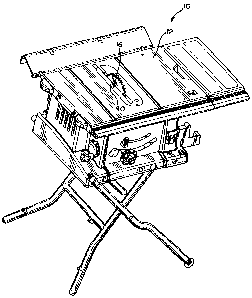Some of the information on this Web page has been provided by external sources. The Government of Canada is not responsible for the accuracy, reliability or currency of the information supplied by external sources. Users wishing to rely upon this information should consult directly with the source of the information. Content provided by external sources is not subject to official languages, privacy and accessibility requirements.
Any discrepancies in the text and image of the Claims and Abstract are due to differing posting times. Text of the Claims and Abstract are posted:
| (12) Patent: | (11) CA 2638048 |
|---|---|
| (54) English Title: | CUT FINISH ACTUATOR FOR TABLE SAW |
| (54) French Title: | ACTIONNEUR DE FINITION DE COUPE POUR TABLE DE SCIAGE |
| Status: | Expired and beyond the Period of Reversal |
| (51) International Patent Classification (IPC): |
|
|---|---|
| (72) Inventors : |
|
| (73) Owners : |
|
| (71) Applicants : |
|
| (74) Agent: | MACRAE & CO. |
| (74) Associate agent: | |
| (45) Issued: | 2011-11-08 |
| (22) Filed Date: | 2008-07-17 |
| (41) Open to Public Inspection: | 2009-01-23 |
| Examination requested: | 2008-07-17 |
| Availability of licence: | N/A |
| Dedicated to the Public: | N/A |
| (25) Language of filing: | English |
| Patent Cooperation Treaty (PCT): | No |
|---|
| (30) Application Priority Data: | |||||||||
|---|---|---|---|---|---|---|---|---|---|
|
A table saw having an actuator to stop rotation of the cutting blade when the cutting operation for the material being cut is complete. The actuator is located adjacent the cutting blade near the midpoint of the opening through which the cutting blade extends.
Une table de sciage comprenant un actionneur permettant d'arrêter la rotation de la lame de coupe si l'opération de coupe du matériau à couper est terminée. L'actionneur est situé à proximité de la lame de coupe près du milieu de l'ouverture dans laquelle la lame de coupe se prolonge.
Note: Claims are shown in the official language in which they were submitted.
Note: Descriptions are shown in the official language in which they were submitted.

2024-08-01:As part of the Next Generation Patents (NGP) transition, the Canadian Patents Database (CPD) now contains a more detailed Event History, which replicates the Event Log of our new back-office solution.
Please note that "Inactive:" events refers to events no longer in use in our new back-office solution.
For a clearer understanding of the status of the application/patent presented on this page, the site Disclaimer , as well as the definitions for Patent , Event History , Maintenance Fee and Payment History should be consulted.
| Description | Date |
|---|---|
| Time Limit for Reversal Expired | 2015-07-17 |
| Letter Sent | 2014-07-17 |
| Grant by Issuance | 2011-11-08 |
| Inactive: Cover page published | 2011-11-07 |
| Inactive: Final fee received | 2011-08-25 |
| Pre-grant | 2011-08-25 |
| Notice of Allowance is Issued | 2011-03-31 |
| Letter Sent | 2011-03-31 |
| Notice of Allowance is Issued | 2011-03-31 |
| Inactive: Approved for allowance (AFA) | 2011-03-21 |
| Amendment Received - Voluntary Amendment | 2011-02-07 |
| Amendment Received - Voluntary Amendment | 2010-05-11 |
| Inactive: S.30(2) Rules - Examiner requisition | 2009-11-12 |
| Application Published (Open to Public Inspection) | 2009-01-23 |
| Inactive: Cover page published | 2009-01-22 |
| Inactive: First IPC assigned | 2009-01-07 |
| Inactive: IPC assigned | 2009-01-07 |
| Inactive: IPC assigned | 2009-01-07 |
| Inactive: IPC assigned | 2009-01-07 |
| Amendment Received - Voluntary Amendment | 2009-01-06 |
| Inactive: Filing certificate - RFE (English) | 2008-09-16 |
| Filing Requirements Determined Compliant | 2008-09-16 |
| Letter Sent | 2008-09-16 |
| Application Received - Regular National | 2008-09-16 |
| Request for Examination Requirements Determined Compliant | 2008-07-17 |
| All Requirements for Examination Determined Compliant | 2008-07-17 |
There is no abandonment history.
The last payment was received on 2011-07-06
Note : If the full payment has not been received on or before the date indicated, a further fee may be required which may be one of the following
Please refer to the CIPO Patent Fees web page to see all current fee amounts.
| Fee Type | Anniversary Year | Due Date | Paid Date |
|---|---|---|---|
| MF (application, 2nd anniv.) - standard | 02 | 2010-07-19 | 2008-07-17 |
| Application fee - standard | 2008-07-17 | ||
| Request for examination - standard | 2008-07-17 | ||
| MF (application, 3rd anniv.) - standard | 03 | 2011-07-18 | 2011-07-06 |
| Final fee - standard | 2011-08-25 | ||
| MF (patent, 4th anniv.) - standard | 2012-07-17 | 2012-06-14 | |
| MF (patent, 5th anniv.) - standard | 2013-07-17 | 2013-07-01 |
Note: Records showing the ownership history in alphabetical order.
| Current Owners on Record |
|---|
| EASTWAY FAIR COMPANY LIMITED |
| Past Owners on Record |
|---|
| WADE BURCH |
| WILLIAM C. BUCK |